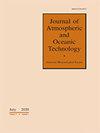非天顶仰角对地基红外热力学反演的影响。
IF 1.9
4区 地球科学
Q2 ENGINEERING, OCEAN
引用次数: 0
摘要
观测行星边界层内的热力学剖面对于理解和预测大气现象至关重要,因为该层内的陆地和大气之间存在显热和潜热的显著交换。大气发射辐射干涉仪(AERI)是一种基于地面的红外光谱仪,用于获得温度和水蒸气混合比的垂直剖面。大多数AERI只能看到天顶,尽管海洋AERI(M-AERI)的设计允许它查看各种仰角。在这项研究中,我们量化了当包括非天顶角时,反演剖面的信息内容和精度的提高,这在微波辐射计剖面仪中很常见。通过合成研究和ARM云气溶胶降水实验(ACAPEX)活动的M-AERI观测,对额外扫描角度的影响进行了量化。模拟研究表明,低仰角对温度的信息含量较高,而高仰角对水汽的信息含量较大。在非常潮湿的环境之外,与温度和水蒸气混合比的高角度相比,低仰角的添加也会导致较低的均方根误差,尽管这主要是将多个观测值平均在一起以降低仪器噪声的结果。ACAPEX数据集的真实世界结果表明与模拟研究的结果相似,尽管由于样本量小和观测不确定性,并非所有预测的效益都能实现。本文章由计算机程序翻译,如有差异,请以英文原文为准。
The impact of non-zenith elevation angles on ground-based infrared thermodynamic retrievals.
Observing thermodynamic profiles within the planetary boundary layer is essential to understanding and predicting atmospheric phenomena due to the significant exchange of sensible and latent heat between the land and atmosphere within that layer. The Atmospheric Emitted Radiance Interferometer (AERI) is a ground-based infrared spectrometer used to obtain the vertical profiles of temperature and water vapor mixing ratio. Most AERIs are only capable of zenith views, though the Marine AERI (M-AERI) has a design that allows it to view various elevation angles. In this study, we quantify the improvement in the information content and accuracy of the retrieved profiles when non-zenith angles are included, as is common with microwave radiometer profilers. The impacts of the additional scan angles are quantified through both a synthetic study and with M-AERI observations from the ARM Cloud Aerosol Precipitation Experiment (ACAPEX) campaign. The simulation study shows low elevation angles contain more information content for temperature while high elevation angles have more information content for water vapor. Outside of very humid environments, the addition of low elevation angles also results in lower root mean square errors when compared to high angles for both temperature and water vapor mixing ratio, although this is primarily a result of averaging multiple observations together to reduce instrument noise. Real-world results from the ACAPEX data set indicate similar results as the simulation study, although not all predicted benefits are realized due to the small sample size and observation uncertainties.
求助全文
通过发布文献求助,成功后即可免费获取论文全文。
去求助
来源期刊
CiteScore
4.50
自引率
9.10%
发文量
135
审稿时长
3 months
期刊介绍:
The Journal of Atmospheric and Oceanic Technology (JTECH) publishes research describing instrumentation and methods used in atmospheric and oceanic research, including remote sensing instruments; measurements, validation, and data analysis techniques from satellites, aircraft, balloons, and surface-based platforms; in situ instruments, measurements, and methods for data acquisition, analysis, and interpretation and assimilation in numerical models; and information systems and algorithms.

 求助内容:
求助内容: 应助结果提醒方式:
应助结果提醒方式:


